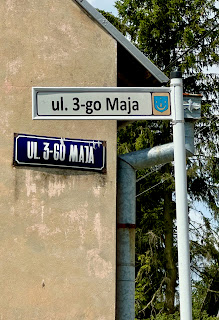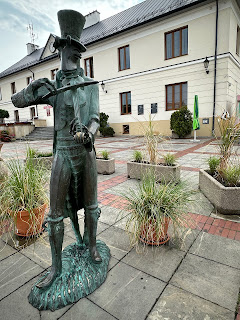Thursday, July 4, 2024
Searching for the Braufenbreners (Brenners): Frampol and Shebershin (Yiddish) Szczebzreszyn
Wednesday, July 3, 2024
Auschwitz-Birkenau
I have been putting off the writing of this post because it is an emotionally draining experience. When we were getting near the camps, I was a bit taken aback at all the homes that surrounded the camps. Once we were inside, there were times I needed to look away or leave the room. I have seen many movies and read a wide variety of books about the Holocaust, but nothing was like visiting the two concentration camps. I will not do it justice here, but I will try to give you a sense of our visit. I didn't take many pictures.
I will start with logistics. Since we were not traveling with a large tour group, we had tickets for an English group tour with about 25 others who were in a similar situation. As you walk into the visitor's center you check in and wait for your time to be called. Other small groups seemed to have a private guide. Large groups were met outside where there were several guides waiting for them.
Once gathered with our guide, we went through security and picked up "whisperers" so that we could hear the guide throughout the tour of Auschwitz. We did not have the audio at Birkenau. As we went through the infamous gate "Arbeit mach frei," or "Work makes you free," it seemed disrespectful somehow to take a photo, besides the point that there are so many groups of people it was difficult to take a photo. Still, I grabbed my phone and got this view.
I learned that the camp was built by the Russians before the war as a training ground for soldiers. The Nazis turned it into a death camp. We walked past the 24th block to the first barracks. The start of the tour is a museum with each barrack showcasing the horrors of the camp. Prisoners undressed and their personal belongings were taken from them. The exhibit included items such as tallit (prayer shawls), housewares (people were told they were being relocated and could take some items so that they would be more obedient and less afraid), luggage, and shoes, including one window that only displayed shoes of the children that were murdered. I had to look away. I couldn't stop thinking of Ari and the tremendous loss of generations.
We went into another barrack that was for the prisoners who worked. I was astonished by the beautiful murals that decorated most of the rooms, even more so when our guide explained that all of them were created by the prisoners. Some were allowed to keep paint and pencils that were used to create life in a place of death.
As we came to another barrack, we walked into an alcove that was used to shoot prisoners against the back wall. There is also a prison within a prison where the deranged minds of the Nazis came up with numerous ways to punish prisoners. There was one room where people were forced to stand all night and then work all day. The Nazis would fill another room that had no ventilation with as many prisoners as they could. The people would suffocate from the lack of oxygen. There was no end to the horrors.
By the time we reached the crematorium I was so overwhelmed that I just glanced at the ovens and walked out of the building to get some fresh air, something the victims of the Holocaust will never have. I didn't take any photos of the crematorium.
Once we had made our way through Auschwitz, we returned our whisperers and were instructed to meet at the shuttle bus after taking a brief break. Together we were taken to Birkenau, which unlike Auschwitz, was built as a concentration camp. It was enormous. The wooden barracks were burned to the ground, leaving only the chimney for a fireplace that was the only heat in the winter. 90% of those who died in the complex which is called Auschwitz died in Birkenau, the largest of the sub-camps.
The pictures we see in books and movies of the barracks with three layers of what was the sleeping area for the prisoners was actualized in a remaining barrack. The lowest bunks were for the arriving prisoners who, when people in the upper bunks had to relieve themselves, would have it fall upon them.
1.1 million men, women, and children lost their lives here. This included Jews who made up most of the population, but also gypsies, political prisoners, the disabled, and homosexuals. The camp was liberated between January 17th and 21st. Before the liberation, 58,000 prisoners were moved by the SS deeper inside the Reich. The SS burned as much as they could, including the warehouse of personal belongings of the prisoners, and they attempted to blow up the crematorium, some of which was destroyed, but at least one oven remained. The Russian troops rescued 7,000 prisoners, most of whom were very ill and starving. A hospital was set up in the camp with doctors to provide care. Auschwitz became a museum soon after the war in 1947. It is a difficult but necessary visit.
Tuesday, July 2, 2024
Old Town Krakow
Our five-star hotel, Hotel Polski Pod Bialym Orlem, was well located in the Old Town of Krakow right at in front of the Brama Florenska, a 14th century Gothic watch tower with a statue of Pan in front and a sidewalk art gallery with manufactured paintings for sale. This allowed us to explore the area leisurely over the two days that we had time.
Florianska is a pedestrian street filled with restaurants, shops, ice cream, and bizarre tourist attractions like the Museum of Torture! (No, we didn't go.) It was also filled with tourists and local alike and maniacs on bicycles that swerved around us, frighteningly so at times. We had a sampling of a local cherry drink at Pijana Wisnia. It was a bit sweet but good, a little like the old Cherry Heering my father used to drink.
The main square was populated with a Renaissance-style market arcade with various Polish souvenirs and a 19th century Polish art museum, Sukiennice. Children were delighted with the pigeons that were as numerous as those in St. Mark's Square in Venice.
Our local representative from JayWay Travel, Adam, set us up with a tasting at a distillery, Miodula, which makes their alcohol and liqueurs from old traditional recipes. We assumed it would be similar to tasting we had done at home, but by the time we finished about 2 hours later we had tasted 14 different drinks from their best know Staropolska, a honey vodka, to the horseradish vodka, that after smelling it, I didn't want to give it a try. By then I don't think I could have had any more. After the tasting we both created our own drink with a moonshine base. She gave us about 10 ingredients from which we can use to add flavor. I remember adding honey, cloves, huckleberry, and a couple of other ingredients I can't remember. I am going to attempt to get it home. (She said the longer it sits the better it will be.) If you are reading this and want to taste it send me a text and we will have a tasting party. There is no guarantee it will be drinkable.
On our last day in Krakow we visited the Wawal Royal Castle and the famous dragon that breathes fire about every three or four minutes. Tired of guided tours, we decided to explore it on our own and with the help someone at the ticket booth we chose a ticket that included the treasury, various rooms in the castle, and the gardens. The castle was the residence of the kings of Poland and the symbol of Polish statehood. Today it is a museum that contains various artifacts, furniture, and decoration as well as hundreds of years of painting, prints, porcelain, and armor. They also had an exhibit of Turkish tapestries.
The beautiful Royal Gardens were also decorated temporarily with metal statues of people, mostly men with a few women and winged horses. The gardens also offered beautiful views of the city below. After strolling through the gardens and taking numerous photos, we set out to find the famous Wawel Dragon. It wasn't easy, but we finally realized we had to follow a path around the castle and down to the Vistula River. Once we reached the water we just had to follow the crowd. The dragon is from Polish mythology that is said to have lived in a cave under Wawal Hill before the city of Krakow was founded. I knew Ari might like to see the fire-breathing dragon, so I took a video to send him. On the way back to our hotel we passed an alcohol-free frozen mojito which was just the thing to gain enough energy to make our way back in the heat.
Searching for the Braufenbreners (Brenners): Frampol and Shebershin (Yiddish) Szczebzreszyn
Direction sign on our visit to the Braufenbrener and Waldman ancestral homes I was never much interested in genealogy nor my family histo...

-
Direction sign on our visit to the Braufenbrener and Waldman ancestral homes I was never much interested in genealogy nor my family histo...
-
Map showing all the cities from which people were deported to Auschwitz I have been putting off the writing of this post because it is an em...
-
Our five-star hotel, Hotel Polski Pod Bialym Orlem , was well located in the Old Town of Krakow right at in front of the Brama Florenska, a ...















.jpeg)




















































